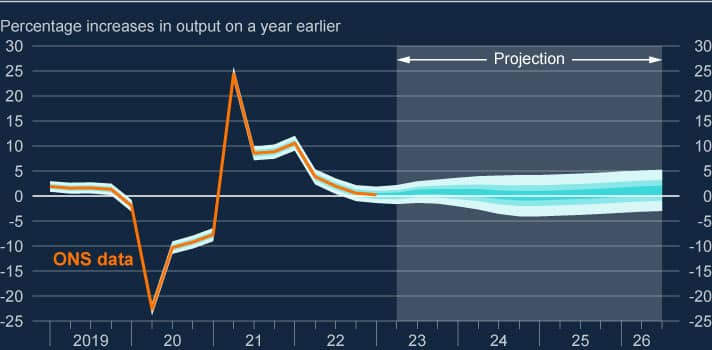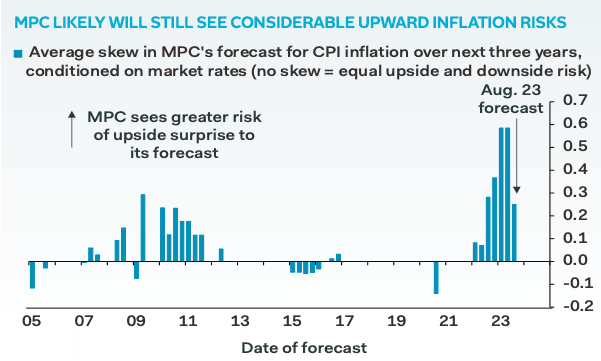How the Bank of England Can Support Pound Sterling Into Year-end
- Written by: Gary Howes
-
- Pound to Euro rate @ 1.1480
- Pound to Dollar rate @ 1.2140
- Breakdown of MPC votes to provide initial signal to FX market
- Followed by any changes to the Bank's economic forecasts

Image © Adobe Stock
The British Pound can walk away unscathed from the Bank of England's November interest rate decision if no members of the Monetary Policy Committee (MPC) vote for a rate cut and inflation and growth forecasts do not change drastically.
This is because keeping interest rates unchanged is entirely expected and will be of little consequence to financial markets. Instead, for forward-looking financial markets, it is the guidance in the Statement and forecasts in the Monetary Policy Report that will matter.
"It's unlikely the BoE will want to close the door to further tightening, so the MPC will likely want to ensure that its previous 'high-for-longer' message is the key takeaway from November’s policy statement. Such a message should provide sterling some support," says George Vessey, Lead FX Strategist at Convera.
"We see no further hikes in the base rate, accompanied by rhetoric that suggests rate cuts are a long way off. This message could provide some upside for GBP, given the already rather low expectations for additional tightening," says Matthew Ryan, Head of Market Strategy at Ebury.
A message of 'higher-for-longer' will be telegraphed in the statement and minutes, but the words will sound hollow unless given credibility by 1) the composition of the MPC vote and 2) the economic forecasts.
Regarding the vote, the market expects a solid majority to vote for rates to be kept unchanged, but an initial downside risk for GBP would involve Swati Dhingra - the most dovish on the MPC - breaking ranks and voting for a rate cut.
This is something economists at Barclays are expecting, and it would amount to an initial signal to markets that the MPC is now discussing rate cuts. If Dhingra votes for a cut, the minutes would need to reference her decision and any associated discussions.
This could provide a signal to financial markets that rate cuts are closer than previously thought.
The typical FX response function suggests the Pound could weaken on such an outcome, but it is unlikely that this alone will be enough to prompt a significant selloff.
The economic forecasts will be of importance as these are utilised by the MPC to guide the market's interest rate expectations, which in turn has real-world impacts on both the cost of borrowing and the exchange rate.
Above: The Bank of England's existing growth forecasts.
For example, by releasing forecasts that show inflation is set to fall below the 2.0% target by 2025, markets are able to assume the Bank will be in a position to cut interest rates from some point in 2024. How these forecasts shift would result in a finessing of expectations.
The rule of thumb is that an upgrade to growth and inflation forecasts can be read as a concrete sign the Bank will stick to its word on the need to keep rates higher for an extended period.
But a downgrade in both growth and inflation projections makes such guidance seem hollow, which can allow the market to bring forward rate cut expectations, which would likely result in a softer Pound.
(For a more comprehensive look into what to expect of the inflation forecast changes, please see this coverage of Pantheon Macroeconomics's preview.)
"The inflation forecast for 2025 will be important, currently below target, a potential upward revision would prompt the BoE to reverse not before the Fed and/or the ECB, offering the pound further support," says Asmara Jamaleh, an Economist at Intesa Sanpaolo.
Image courtesy of Pantheon Macroeconomics.
But Derek Halpenny, Head of Research for Global Markets at MUFG, sees the inevitable acknowledgement of weaker data and some evidence that the labour market conditions point to reduced wage inflation risks.
He says this can push UK bond yields lower and result in a softer Pound.
"The UK OIS curve has more potential to adjust lower further out – just 25bps worth of cuts by September 2024 looks too conservative to us and a less hawkish communication on Thursday could push yields at the back end of next year lower – leading to some further GBP underperformance," says Halpenny.
For GBP/USD, the October low of 1.2037 will be the key support level, he adds.
Simon Harvey, who heads research at international payments firm Monex, says the Bank won't
significantly revise projections for growth, with current indicators broadly consistent with staff estimates for the economy to stagnate.
"Whilst not great, this is still better than where the UK economy was set to be at the start of the year and where most forecasts place the eurozone in the coming months, which increasingly see recession as the baseline," says Harvey.
He explains that any such prediction for UK growth outperformance on a relative basis, combined with an improving real rates profile as inflation cools, "is a mix that should be supportive of the pound into year-end".













